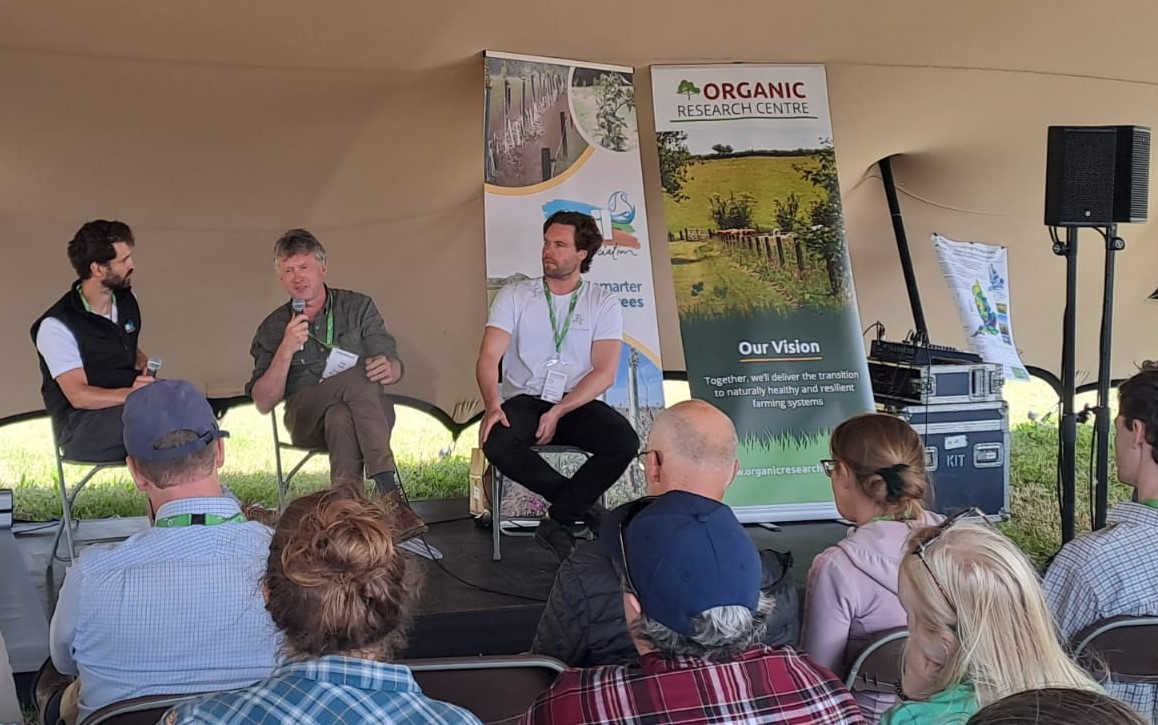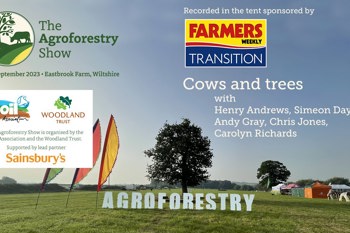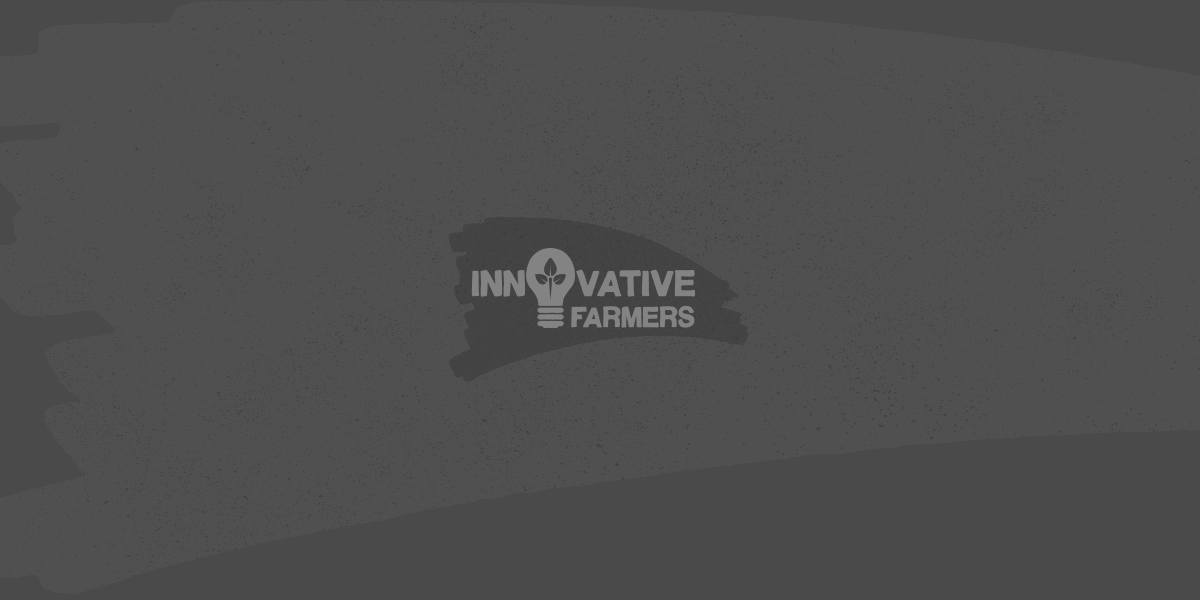




In this research network, seven farms and a research farm are being supported to design and implement silvopasture systems: planting trees within pasture fields used by livestock. Three designs are being tested with a mixture of cluster planting, regular spacing and shelterbelts being planted.
This farmer-led project was created as there has been limited research on the impact of silvopasture in the UK. With excitement about agroforestry on the rise, farmers are looking for clear evidence of a potential return on investment in order to justify the significant financial commitment to turn pasture over to silvopasture.
The farm enterprises are currently a mixture of dairy, beef, sheep and arable. Over 12 years, the farmers will monitor tree establishment and factors that may effect this (fencing, wildlife, livestock interactions and the use of decoy rubbing posts and 'sacrificial willow' to distract livestock from protected trees and shrubs).
Click on the brown banner above for latest activity and other information
Silvopasture is meant to bring the following benefits:
The field lab will work with multiple partners to conduct research across a range of topics, looking at environmental and animal behavioural metrics as well as certain practical management considerations.
The Woodland Trust worked with the farmers to design a planting system to suit their farm, and provided funding to cover the planting and tree protection. For information on planting designs please see “Three silvopasture designs to suit your farm”.
A fuller description of the trial design and the roles of the different stakeholders can be found in the reports and results section of the field lab page.
To really establish the benefits and impact of silvopasture over the 12-year period, a variety of tests will be taken. The wealth of quantifiable data that this field lab will offer will help researchers to better understand the impact of silvopasture, including different designs, on the wider farm system.
The tests will include:
Surveys in vegetation, soil organic carbon, and insect communities and how trees affect these metrics as they grow.
Looking at sward competition and rates of growth at different stages of tree canopy development
Biodiversity research looking at bats, birds and dung beetles and population as the agroforestry system matures.
Monitoring tree establishment rates and practicalities of looking after the trees – considering factors such as climate, competition, and stock eating the trees.
When the livestock have been introduced, various welfare assessments will also be undertaken.
Devon Silvopasture triallist Andy Gray shares his experiences of agroforestry at the Groundswell Agroforestry tent. Andy talks to Soil Association's Jon Haines to share his ideas on marketing agroforestry products.

Andy Gray talks at the Groundswell agroforestry tent
The Devon silvopasture network have been working with the BTO to detect bats at some of the silvopasture trial farms.
A survey and sampling protocol was devised that allowed farmers to deploy static acoustic bat detectors over a 7-month survey season to provide baseline data for bats.
A full report (which can be found at the results and reports tab) provides an overview of the survey coverage and main results from 2023.
During 2023, 30 different locations across the Elston Farm, farming cluster were surveyed. Recording was undertaken on 94 different nights mainly between April and the end of October.
Following validation, the study confirmed the presence of 15 bat species, 2 small mammal species, and 4 species of bush-crickets. Through the project, we have a better understanding now of the status of all species of bats on the farms surveyed.
The full report can be found on the results and reports tab of the field lab webpage.
In September members of the Devon Silvopasture Network spoke at a very well-received session at the Agroforestry Show. You can watch the session here:
Dr Carmen Segura-Quirante updated the group on the baseline soil sampling results which were taken between Dec 2020 and Feb 21:
· Different protocols and tests have been followed to determine physical (bulk density and texture fractions) and chemical (pH, % SOC and TN) soil properties
· Bulk density analysis (BD) and chemical analysis were carried out in North Wyke, and texture fractions were provided by an external laboratory from baseline soil subsamples processed at North Wyke
· Estimated time effort in working hours for the baseline soil study =2000 h. Lab team= 8 people
· Tests to check the presence/absence of inorganic C (IC) were based on acidified washing procedures of soil subsamples when pH > 6
· We assume Soil Total Carbon (IC + OC) = Soil Organic C as no evidence of IC was found (pH < 6 in most of the samples and no effervescence when higher pH)
· The composite sample approach is an accurate method to determine SOC at baseline level. In our case 1 composite sample= 6 samples from the same strata and per depth. To do the composite sample, we took a subsample of each individual sample to keep spare soil in our archives for the future.
· SOC and TN (%) were determined by standardized and recommended methods to assess changes in SOC (Carlo Erba elemental analyser)
· SOC stocks were calculated from SOC (%), BD (g/cm3) and soil depth (cm) for 0-10 cm and 10-30 cm soil depths
· Mean values (% SOC) in the topsoil (0-10 cm) were in the range of values reported in the UK for arable fields and grasslands
The individual results will be sent out to the farmers themselves shortly.
The next samples will be taken within 4 years of the initial samples by Rothamsted.
We have pending to pass the questionnaire about land use and management to them.
Rothamsted research visited the farms in February and March to undertake baseline sampling and will monitor the change of this over the next 12 years to understand whether the integration of trees improves soil organic carbon sequestration and soil structure.
Advisors from the Woodland Trust and FWAG visited each farm in autumn 2020 to develop tree planting designs unique to the needs of each farmer. The trees (funded by the Woodland Trust) were planted at the farms throughout February, with some farms involving dozens of local volunteers in the planting.
Three planting designs will be used overall - shelterbelts, regular spaced strips and open-grazed clustered wood pasture. The farms will use one or more of these designs across their fields. The benefits and drawbacks of each design are detailed here.
For example, regular spaced strips allow machinery access to alleys for cutting silage if farmers wish to manage this as productive grassland throughout the year. However, the prioritisation of grass in this design means the least biodiversity benefits are expected of all three designs.
10th September 2020
January 2021
February 2022
March 2021
May 2021
Early summer 2022
Early summer 2023
Early summer 2024
Early summer 2025

FWAG SW
South West England
Simeon has worked in the countryside management industry for over 25 years where his roles have taken him from tree surgery in Australia to installing forest school facilities in the South West, via managing Nature Reserves, orchards, hedgerows and veteran trees and leading team building events that deliver practical conservation projects for charities across the UK. Drawing on his strong arboriculture background and experience, as Regional Hedgerow, Orchard and Agroforestry Specialist, Simeon provides advice and training across the region to advisers, farmers and organisations on the planting and management of trees outside of woodlands. He leads the FWAG SW Tree Team.

Rowden Farm
Devon

West Elmett Farm
Devon

Ashridge Court
Devon

Hill and Coombe Dairy
Devon

Warson Farm
Devon

Organic Research Centre
UK

Rothamsted Research
UK

Rothamsted Research
UK





